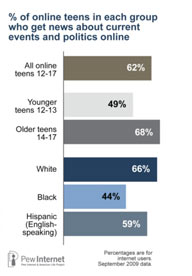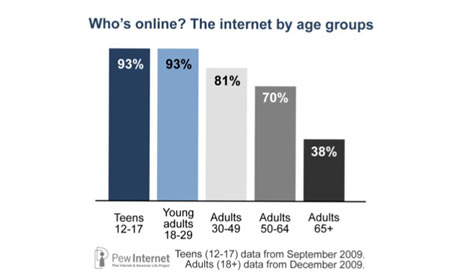First the Guardian's POV:
----------------------
Teens prefer reading news online to Twitter
While most teenagers reject Twitter and blogging, 62% of them like to read their news online, US research reveals
Will the next generation read news reports? It looks like it. Some 62% of US internet users aged 12 to 17 are going online for news and political information or find out about current events, said a study conducted by the Pew Research Center published yesterday. During special events such as general elections news consumption rose to 77%.
This is indeed an impressive number, even more so if you compare it with the 73% of teens who use social networking websites or the 89% of boys and 70% of girls who report they have a game console.
It also stands up well compared with the 72% of adult internet users who get their news online, a number that has held fairly constant since 2002 according to Pew. In general, it says the use of online news has increased dramatically since its first analysis, in 2000, when it found just 35% of online adults were reading political news online.

As was expected in all age groups educational attainment and income are positively correlated with getting news online: 81% of college educated internet users get their news online, a figure that drops to 59% with a lower education.
Blogging isn't mainstream, social networking is
Blogging, on the other hand, may become more and more of a side issue. In fact, among all the content creating activities the decline in blogging among teens and young adults is striking as it looks like the youth may be exchanging "macro-blogging" for microblogging with status updates. Since 2006 blogging among teens has dropped from 28% to 14% and among young adults (aged 18 to 29) by 24% to 15%. Some 11% of those aged 30 and over now maintain a personal blog, and 14% of them maintain a personal website.
According to the research, 26% of adults post comments online, a while 30% share online content. Teens on the other hand are enthusiastic online commenters within the social networks. A massive 86% of social networking teens post comments to a friend's page or wall on a social network site and 83% post comments on friends' photos posted to an online social network.

They don't really like to use Twitter, though. While 19% of adult internet users use Twitter or similar services to post short status updates and view those of others, only 8% of 12- to 17-year-olds do so.
Young adults lead the way when it comes to using Twitter or status updates as a third of 18- to 29-year-olds post or read status updates, and they are also the only age group which prefers to use laptop computers to desktop computers.
Mobile internet access is becoming more important
However, the study found out that access to the internet is changing in general. Teens and adults no longer access the internet solely from a computer or laptop but now go online via portable devices such as mobile phones or game consoles as mobile access to the internet becomes more and more important.
And finally some more background figures: 75% of teens and 93% of adults aged 18 to 29 now have a mobile phone. Some 93% of teens aged 12 to 17 go online, as do 93% of young adults aged 18 to 29, and even an impressive 74% of all adults aged 18 and older. Among them, Facebook is currently the most commonly‐used online social network as 73% of online adults have a Facebook profile. More than half of them say they have two or more different profiles.
So what do these figures say, apart from the fact that teenagers obviously like to read the news?
Conclusion
Mobile access to the internet is on the rise, and the reading of news on the platform is likely to follow this development. Offerings such as the New York Times's Times People or the HuffingtonFacebook are likely to become more common to encourage young people to share articles and debate with their friends. Post's deep integration of
That might be a reason why social networking sites such as Facebook are taking over from blogging – as it appears that blogging has levelled out at a figure of about 15% of internet users.
Pew Internet drew data from a survey conducted in the second half of 2009 among 800 young people aged between 12 and 17, and compared these figures with previous research.And now from Mashable
---------------------------------------
Teens Just Don’t Blog or Tweet [STATS]
 A new study published today by Pew Internet finds that teens and young adults are blogging less and using social networking sites more, with the prominent exception of Twitter.
A new study published today by Pew Internet finds that teens and young adults are blogging less and using social networking sites more, with the prominent exception of Twitter.
Pew’s Report surveyed 2,253 American adults and 800 U.S. teens to get a reading of how they use the Internet, which gadgets they own, and which social media tools they use the most.
Some of the data will surprise you.
The Internet’s Everywhere
Here’s a no-brainer: Young adults use the web far more than older adults. In its study, Pew found that 93% of teens and young adults go online, compared to only 38% of adults over 65 years of age. It surprises us that 7% of 12-29 year olds still don’t browse the web, but some just don’t have or can’t afford access.

Among those teens going online, 63% say they go online at least once a day, with older teens more likely to go online than younger teens.
Most are connecting with high-speed connections as well. Seventy-six percent of families with teenage children have broadband connections, while 10% still use dial-up, 8% have no computer and 4% have a computer but no Internet access. For comparison, 49% of families used dial-up in 2004.
The Internet’s getting faster and more accessible. As computer prices drop and Internet access becomes more readily available, we should see these Internet usage numbers continue to rise.
The Laptop Is More Popular than the Desktop
In terms of gadgets, more teenagers have cell phones (76%) than a computer (69%). More than half of 12 year olds own a mobile phone, while a rather impressive 83% of teenagers carry a cell phone in their pockets. That number only rises with age — a full 93% of 18-29 year olds own a cell phone.
The mobile trend even continues into the computing realm: Laptops have overtaken the desktop for those under 30. Sixty-sex percent of adults 18-29 own a laptop, while 53% own a desktop. Other interesting trends: Males are more likely to own a cell phone, income dramatically affects computer ownership but not cell phone ownership, and race is a non-factor when it comes to the percentage of adults using cell phones.

Teens Just Don’t Blog. Or Tweet.
As you might have guessed, Pew found that teens are avid social networkers: 73% of 12-17 year olds, in fact. They are posting pictures, commenting on status updates and sending IMs.
What they aren’t doing much of, though, is blogging and tweeting.
Pew’s study finds that blogging has dramatically decreased in popularity with the younger crowed since 2006, where 28% of teens reported that they were bloggers. Now that number has dropped to just 14%. Interestingly enough, lower income households (under $50,000) report more blogging than higher income ones. With Facebook (), Twitter () and other social tools to keep your friends updated about your life, blogging just isn’t as necessary.
Perhaps we shouldn’t include Twitter in that list of social media tools teens use, though. As we’ve reported on multiple occasions, teens don’t tweet, and Pew’s numbers don’t disagree with that assertion:

Yes, only 8% of teens use Twitter, remarkably small when compared to most social networks. Only one in 10 high schoolers use Twitter. Among this small group though, the girls are more likely to be microblogging: 13% of 14-17 year old girls reported using the service.
Conclusions: Teens Aren’t Heavy Content Creators
First, it’s important to note that most of this data was taken from September 2009. A lot changes in social media in a five-month period.
With that said, though, the trends seem clear: Teens love to be online, but they’re not terribly interested in writing blog posts or maintaining a stream of tweets. Creating content takes time and energy that they’d rather exert on Facebook, texting, YouTube () or other online activities. And of course, they have school and friends.
Let’s face it: Teenagers haven’t had the time to build up expertise, life experiences or a career that would merit content creation. Without that expertise, fewer people are inclined to listen to what they have to say, and without that knowledge, teenagers have less to talk about.
As my colleague Barb Dybwad also brings up, a teenager’s social circle is far smaller and more closely defined than an adult’s network. Perhaps this is why more closed networks like Facebook are more appealing to teenagers than Twitter, which is a completely public experience. Blogging was a more intimate experience a few years back, which could also explain why more teens have abandoned personal blogs over the last few years.
Combined, it means that Twitter just might not be for the average teenager. Let us know what you think in the comments.





